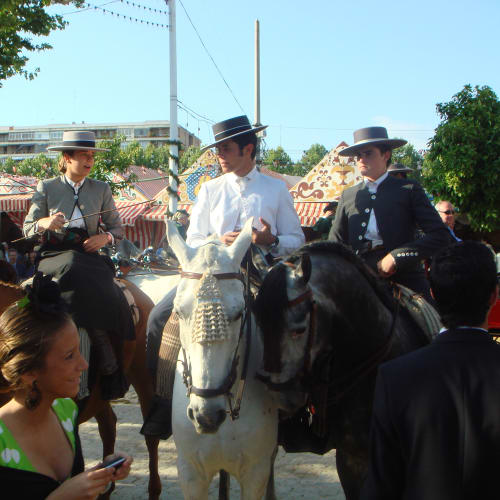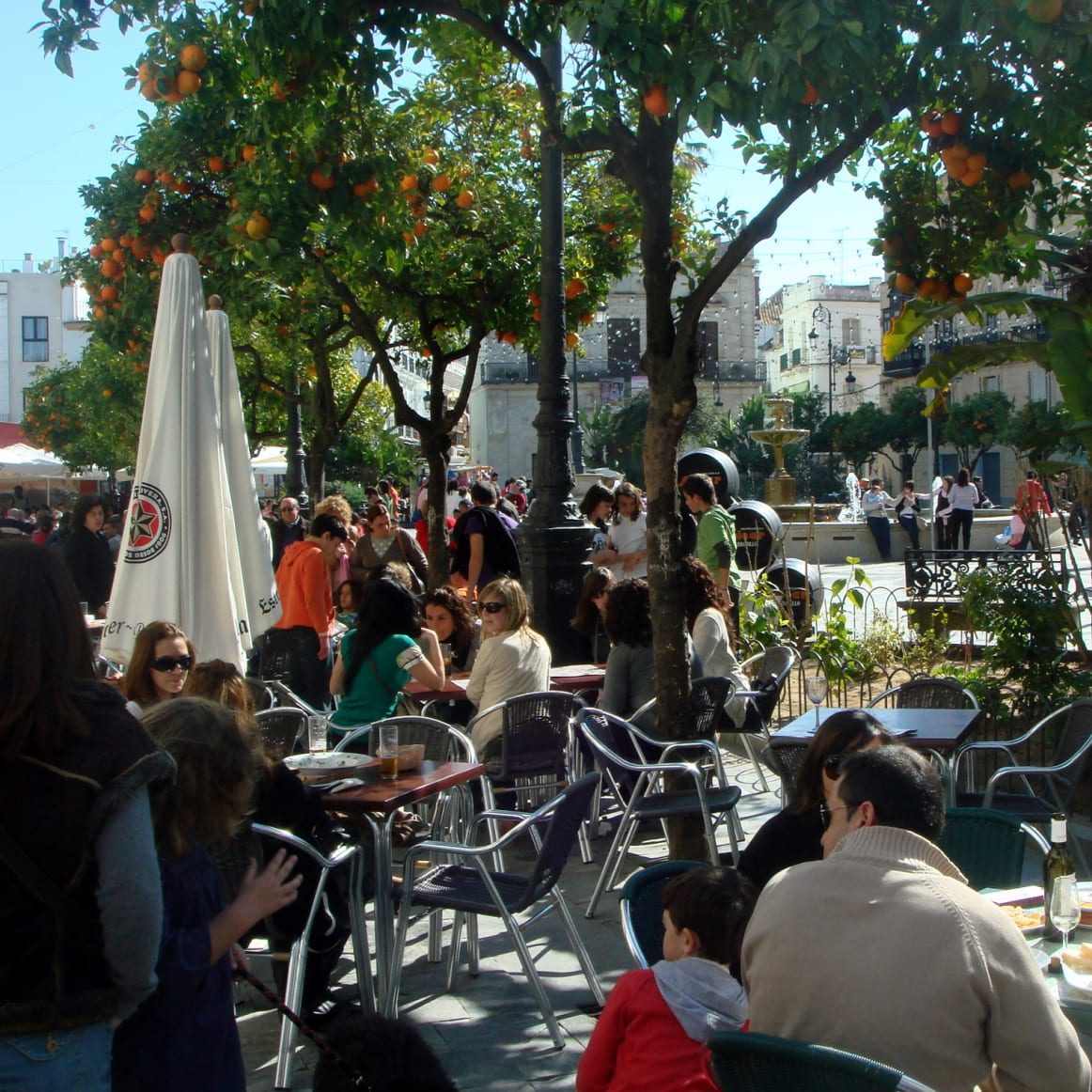Continuity
August 2006




It was dusk that evening in early June -- about 10 PM. I stood on the beach where the Guadalquivir River merges with the Atlantic Ocean and watched the last group of pilgrims disembarking from the barge that had brought them as a group from the La Doñana marshlands on the other side.
They reassembled their procession and proceeded down the beach toward their homes in the village of Bonanza. It was led by a man holding high a cross. Next, on foot, came a small group of other men who must have been the town fathers, or the leaders of the religious brotherhood devoted to the romero. They were followed by a group of people of all ages mounted on beautiful Andalucían horses - and I mean all ages.

For me as a father, the most poignant scene was a little boy, aged 3, who was riding confidently next to his father on his own full sized horse. His father leaned over in his saddle and kissed his son, so proud that his son was now a full-fledged part of the procession of young horsemen.
The procession continued with a group of men and women singing devotional songs to La Paloma - the White Virgin of El Rocío. Several walked with long silver encrusted staffs. They preceded a wooden cart bearing a 'float' of their local Virgin pulled by some of the stronger men, with some women on the other end pushing to help it along in the waterside sand. They were followed by three pairs of magnificent oxen, and most of the rest of the people of the village.
They were a part of the El Rocío pilgrimage, in which each year up to a million ordinary people, as well as gypsies in colorful carts, converge on the remote town of El Rocío. They sing and dance, flamenco songs fill the air -- all leading up to the climactic moment when the 'La Paloma' (the Dove) -- the White Virgin emerges from the church. Some women break into tears and sing mournful saetas; others hold their infants and little children up to touch the Virgin so that they may be blessed by her presence.
Then it is over for another year. The people return home by bus, cart or van singing and visiting with one another. It is a very communal event, which has been going on for over a thousand years - some anthropologists maintain that the origin of this annual gathering is pre-Christian! The liturgical rhythm of the centuries is reenacted each year, and will be for years to come. That little boy on horseback will grow into a young man, then a father, and then perhaps a leader of the brotherhood with his son by his side.
What makes the scene even more remarkable is that 500 years ago this sleepy sherry town was the center of the expansion of the Spanish Empire to the New World! In the first five years of the 16th century between 300 to 400 ships set sail from this bustling port (including those of Columbus and Amerigo Vespucci).
For over 200 years, caravels bound for the Indies would cast off their moorings and head into the treacherous Atlantic from Sanlúcar. Many ships returned laden with treasure in their holds. All the gold was weighed in the neighboring town of Bonanza before being sent up the river to Sevilla. Now Bonanza's glory days are over. It is just a little village -- the final destination of the small group of pilgrims I saw processing down the beach.
Another example of continuity is the stately house in which we spent the month of June. It was built by a sherry family about 100 years ago - with its high ceilings, marble floors, tiled kitchens and patios overflowing with cascades of Bougainvillea. There was even a small lemon tree against the white wall, laden with fruit, to the delight of my grandchildren.

The delightful landlady, María, welcomed us with such grace. She and her five sisters had grown up within these walls. Her husband Miguel told us how he used to come by to see her when she was a very young lady. One thing led to another and now they are a married couple of 40 years or more. He went on to say that his forebears were among the 24 knights who liberated the neighboring sherry town of Jerez de la Frontera from the Moors in the 13th C. His family has been in the area ever since.
We dropped by to see our friend Juan Hidalgo, whose family has been making sherry since 1792 when they came down from the Basque Country. Originally, they were interested in refining salt, but fortunately for all of us they decided to plant vineyards of palomino grapes that now yield La Gitana manzanilla -- the overwhelming favorite wine of Andalucíans at the famous spring fair in Sevilla. Juan showed me and some of my family the bodegas with their endless rows of black American Oak barrels full of the juice of the manzanilla grapes now mellowing into the celebrated wine.
Rumor has it that when the handful of emaciated survivors of Magellan's round the world voyage finally arrived back to Sanlúcar, the first thing they asked for was a healing glass of manzanilla. Of course the story is apocryphal, since that type of wine did not exist at the time! However, we do know that the officers and men of the fleets of Lord Wellington and Napoleon depended upon the Hidalgo family to replenish their supplies of wine.
When Juan showed me the office of his older brother, Luis, who now heads the company, it was if we were stepping back in time. It was the same airy, beautifully tiled office that his father and grandfather occupied when they directed the company. Among the gallery of family members whose pictures were mounted on the wall was a portrait of Luís's and his grandfather. The family resemblance was uncanny!
One final tale - and to me the most engaging. If you visit Sanlúcar in the summer, you will be surrounded by small swarms of young teenagers buzzing around on their 'motos' (motor bikes). They seem to be everywhere, the boys and girls moving together in groups. My Spanish friend explained that they are only repeating the tradition of their parents who do much the same thing - going to their favorite café to visit with their same friends year after year. When these young people were much younger they were with their parents in the cafes and played together around the tables. Now they are coming of age.

I find the thought of such continuity very appealing. This stability may be what first drew me to the culture of Spain so many years ago -- experiencing families who ties go back for hundreds of years. Kids who grow up bonding with the same friends from infancy have no need to posture at the Malls pretending to be what they wished they were. Their friends are life-long. They know who they are.
Except for small pockets of rural America, this is not our experience here in the United States. We do not have the continuity that an age-old culture holds as a common trust. My grandparents were immigrants from Yorkshire, Ulster and Armenia. My wife's are from Holland and Friesland. Our kids have quite the combination of genes!
My family has been enriched by our immersion in different cultures and ways of life. The experience fosters a certain flexibility of worldview. On the other hand, we have not experienced what traditional Spaniards enjoy: that continuity and grounding which comes from living together for generations. As in a close family, many things are mutually understood in a society such as theirs. It encourages a sense of order.
A balance between flexibility and continuity serves us well. There is strength in this fusion of different ways of life. Had my family not come from varying backgrounds, and had we not been willing to live in many different cultures, we never would have discovered the traditions of Spain. In fact, the concept of La Tienda would never have come into being! As in many things, I am grateful for both ways of life - their blending is a wonderful thing.
My best to you and your family,
Don

